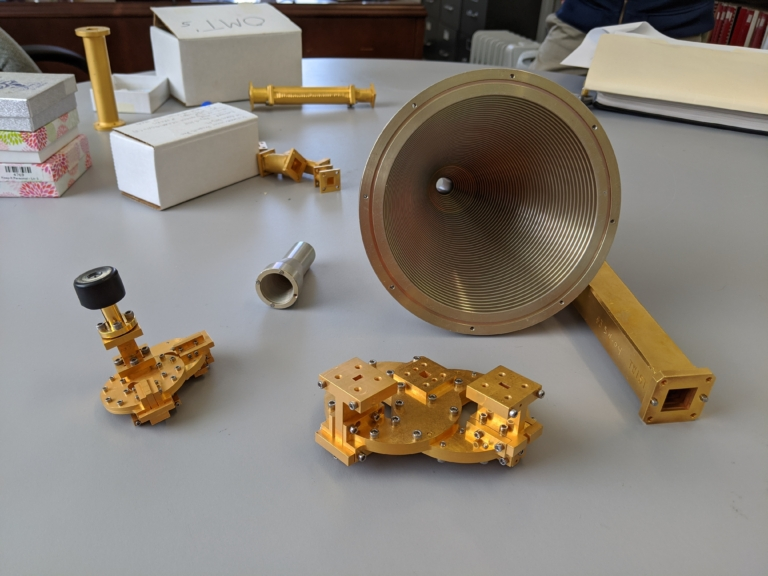Meanwhile, we see photographs of the radio dishes at Very Large Array (VLA) and the Atacama Large Millimeter/submillimeter Array (ALMA) under a starry sky and the splendid scientific images generated by them.
Between these two ends is a difficult set of processes that converts the faint radio signals of distant space into usable scientific information. One of the most essential jobs of CDL is to achieve that transformation effectively.
 Examples of feed horns and waveguides. Image Credit: NRAO/AUI/NSF
Examples of feed horns and waveguides. Image Credit: NRAO/AUI/NSF
Similar to the visible light present all around, radio is also light but with considerably longer wavelengths. Visible light’s wavelength is the same as the size of microscopic bacteria, while radio light has wavelengths varying from millimeters to meters.
It is not possible to capture the radio images on photographic film or transform it into an image by using a simple digital camera. Rather, the signal should be amplified, filtered, and processed in various stages before its data can be stored on a digital chip.
The first of the three stages of the process was performed by Sri Srikanth, which was to capture and focus radio signals so that they are strong and clear. This is carried out using polarizers and feed horns. The feed horn is a funnel-like antenna that amplifies the radio signal. For a feed horn to be effective, it must be scaled relative to the wavelength.
The size of the feed horn must be proportional to that of the wavelength. Ridges within the feed horn help prepare the signal for the polarizer, which divides the signal into perpendicular parts. Such components are designed to carry the signal to the next stage with minimal loss.
The signal must be pre-processed before its conversion from analog radio to digital. A huge part of this stage includes down-conversion and amplification. This is the point where Matt Morgan has a role to play. Morgan develops systems that render the signal usable by computer processors.
Computer chips function at frequencies up to the gigahertz range; however, the radio frequencies captured by telescopes can be nearly a thousand times higher. In the process of down-conversion, the radio signal is combined with another signal of the same frequency.
These two signals combine to create a signal of considerably low frequency. If the process is performed accurately, a gigahertz frequency radio signal comprising all the data of the original signal is formed. After the completion of this process, the signal can be converted into a digital signal.
In the modern world, analog to digital conversion is quite common. This feature is often used to browse cat pictures on the Internet or watch digital television. Conversion of radio astronomy signals is performed similarly, but they contain so much data that users would need a uniquely developed computer chip to maintain the bandwidth.
These chips were initially developed by Omar Ojeda by developing prototypes with off-the-shelf parts, where the size of the prototypes is about that of a laptop. After optimizing and testing the design, it is integrated into chips that can easily fit on the tip of a user’s finger. Such custom designs enable radio telescopes to capture more radio information at lower costs.
Most of this process has to be performed at very low temperatures. Radio light is usually generated by dust and cold gas in deep space. To observe these signals, the detectors must be even colder. This is a specific challenge since power systems and computer processors produce heat as they function.
Joey Lambert, a low-temperature physicist, deals with signal mixers, which are made of superconducting materials and need low temperatures to function.
It is crucial for all of these stages to function together seamlessly; therefore, CDL works jointly with engineers and astronomers to fulfill the requirements as they emerge. Observatories like the VLA and ALMA are at the leading edge of radio astronomy.
These observatories not only offer brilliant radio images but also show how to observe the radio sky in more detail and an effective manner. The CDL functions to guarantee that NRAO observatories will always be advanced.